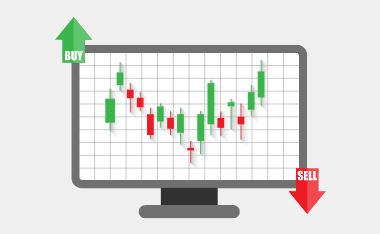What is the Best Forex Trading Stop Loss Strategy?

Forex trading holds massive potential for people to make profit, but it also holds an equal amount of risk of losing money.
This is something that new forex traders need to be aware of because as easy as it might seem to make profits in forex trading, it is also quite easy (if you don’t have the right strategy) to lose those profits and more instantly.
This is because most trading methods don’t account for spontaneous spikes in volatile markets and false trading signals, which can make it difficult for many traders to find consistent profits in their trading.
As a result, it’s vital for new traders especially to adopt proper proven effective forex trading risk management strategies so that they can maximize their profits and minimize their losses.
One example of such a strategy used by almost all profitable forex traders is the stop loss strategy, which focuses on ensuring traders can put an end to a trade once it becomes clear that the trade will result in losses.
When followed, this can help traders to limit their losses to a palatable level, as it brings in a subjective element that reduces the emotional impact involved in making tough decisions when trading.
What is a Stop Loss?
A stop loss can either be a manually executed exit or an automatically triggered pending order that enables traders to set a predefined negative result level on the price chart to close a losing trading position.
The intention is that a strategic stop loss will ensure a minimal loss in funds as a negative trading position is closed.
The term Stop loss is usually abbreviated to (S/L) and it is useful for protecting the trader’s profits by ensuring that a “line in the sand” is drawn at some point to accept that the position is unlikely to give profit and leaves the position with a little loss as possible.
The Stop Loss is a significant component of most forex risk management strategies, because it allows traders to exercise more control over their trades – even those that have not produced a profit.
Types of Stop Loss Execution
Automated
Automated Stop Loss Orders are pre-determined placed orders that traders schedule during their trade, either at the start or during the trade which give their broker instructions to close a position once the price reached a certain level behind their original trade entry point.
This can be used when the trader is holding the position during a period where they will not be physically present on the charts to monitor the trade’s progress.
Manual
Not all traders use Automated Stop Losses. Some traders follow the philosophy that they should be more manually responsive to the market conditions and manually execute their stop loss by personally closing the position when price reaches that pre-determined “worst case scenario”.
Traders who follow this approach are more likely to be intra day traders who will be physically present at all points from trade entry to trade exit.
An Example of a Stop Loss
For instance, an intra day trader enters a buy (long) position at 1.2980 with the expectation that price will continue to rise, with an exit target of 1.3000 (20 pips above their original trade entry level).
The trader understands that the market is volatile and may move in a contrasting direction to their expectation; therefore, they take a calculated risk before entering the market and set a stop loss order automatically or identifies a stop level below the entry price.
If the bid price happens to hit the predefined Stop Loss price of 1.2975, the position gets closed to ensure that the trader only suffers a minimal loss of 5 pips.
On the other hand, if the trader enters the market to take a short (sell) position with the expectation that prices will drop, the Stop Loss is then placed at a price level higher than the entry price, considering the market may become unfavorable at any time causing the price to rise suddenly, contrary to the trader’s expectation.
If the ask price hits the predefined stop-loss price, the position is closed either manually or automatically to ensure only a minimal loss is suffered by the trader.
Determining the “Best” Stop Loss for your Trade.
For a stop loss to be effective, the trader needs to first consider placing it at a logical level.
The logical level should be one that will confirm that their original trade entry decision using their strategy or trade signal was invalid and therefore unlikely to produce a profit from that trade.
We know that the market moves in waves and cycles following strong price level response, with some expectation there will be variation.
As a trader enters a trade and sets their stop loss they must allow for an amount of this variation by thinking about the closest logical level that the market will potentially reach for their trade signal to be proven wrong.
Therefore, in using a stop loss, traders should allocate allowance for the market to breathe while also ensuring that the stop loss is kept as close as possible so that traders can exit the trade as soon as possible in case the market moves in a contrasting direction to their expectations.
The mistake many traders make when using stop loss is that they position it either too close to their entry point, not allowing the market to “breathe” or too far from their entry point, potentially losing more money than necessary because they try to justify their entry, in the face of evidence that shows either their decision or their system was flawed.
There should be a balancing point in the location of their stop loss that allows for the market to find its strongest level to validate the entry price, and alternately recognises that the market is most likely to continue in the opposite direction to the trader’s bias for that trade.
Too close and the trade may be unnecessarily invalidated whilst the market is setting up to move in the direction identified by the trader, or too far and you will throw good money after bad expecting that price will “still turn around” against evidence to the contrary.
Some traders determine their stop loss based upon the amount of loss they are comfortable with in relation to the size of their overall account balance, as if the market will move based upon how much money they have in their account… That is a passive strategy to manage loss for traders who have a weak trading method, that does not have a strong potential for consistent profit.
Instead of using your stop loss strategy that expects a high percentage of losses and trying to manage how long it takes you to lose your money, it may be more effective to employ a trading method that has a high probability of making profit on most trades, whilst employing a strategic trade exit to minimise rare losses and improve the strength of your future trade entries.
The Stop Loss level should be set based upon your intention for the trade (the time you will be in the trade and your projected profit) and the impact of market variation between your trade entry price and expected exit price level over the expected trade duration.
Your Trade Entry Strength Determines Your Stop Loss Strength
Stop Losses are Inextricably linked to the Strength of your Trade Entry Level.
In entering their trade, the trader should allow that the market will move based upon the strength of price levels to those traders who make the market move.
A currency pair moves 1 pip when $10 million US is placed in the market in one direction over the other.
If the trader is not placing a $10 million trade, it is unlikely to move based upon their order.
Your Entry Price should be based upon the price level that you think the traders who make the market move will be most likely to make price move.
Your Stop Loss should be based upon the potential variation at that price level to allow for reasonable flexibility in the price movement whilst the “Big Fish” Traders are making their decisions and placing their trades to make price move.
Let us examine an example of how to potentially use a stop loss.
In this instance, a forex day trader may initiate a Long Trade entry on the GBP/USD at 1.1500 with a potential profit level of 1.1550, while placing a stop loss at the level of 1.1485 (a significant price level recently tested by the market as support, but not recently breached).
This is an indication that the trader has limited their risk of loss on the trade to 15 pips for a potential profit of 50 pips (not including spread).
If the trade goes sideways when the trader enters the trade and gradually moves short, the trader should exit the trade when price hits their stop loss level. This is an opportunity to re-examine their trade entry to see if there were any indications that the price was not likely at that time to move in accordance with their expectations.
If, however, the trade then starts to show a moderate profit after the trade entry, the trader could respond accordingly by modifying the position of the stop loss and trailing it to a level whereby a portion of the trader’s profits is now protected.
Going by the initial example, let us assume that the price rises to 1.1525 after the trader has purchased GBP/USD at 1.1500. The trader may then capitalize on this by adjusting the stop loss to 1.1520 which ensures that 80% of the trader’s profits thus far are protected if the market moves in an unfavorable direction to the trader.
Where many traders make an error in judgment is that they have an “all or nothing” approach, expecting to get all of their projected profit and not responding to the market exhaustion at a level between their trade entry and projected profit.
Using a Trailing Stop Loss as a “Profit Lock”
This strategy allows traders to use a “stop loss” to protect their profits and ‘lock it down’ using a special form of stop loss known as trailing stop.
A trailing stop in a strategy gives a trader the opportunity to find key points while their trade is in profit, to exit a trade and lock in their hard earned profits.
These Stop Loss levels should be congruent with their general trading strategy rules.
They may set the trailing stop loss at a percentage of their expected trade total profit or at a key level of Support or Resistance between their Trade Entry Price and their Profit Target.
For example the trader has entered a Long position with an expected profit of 30 pips and they set a drawback strategy exit where the price exceeds 60% of their expected profit (18 pips) and will exit if it draws back to 50% of their expected profit (15 pips net profit).
If after their trade entry, price continues to rise or maintains a relative pace, the profit lock trailing stop loss will not be triggered.
But if the market switches to an unfavourable direction, and hits the trailing stop of the trader, the trade will close, thus allowing the trader to keep his/her profits.
Long Trade Entry Stop Loss
We’ve agreed that a stop loss should not be placed randomly but rather at a logical level so that traders can exit the trade based upon the market demonstrating that it’s unlikely that the trade will produce a favourable result.
If the trader takes a long position (i.e. buying in on a currency pair upward movement), it is advisable to place the initial stop loss below at a close swing low within the current view of the market.
This approach recognises that the Bull Traders who are driving the market have recently tested and rejected a lower level of support below the trade entry price and at that point, the Bear Traders have not taken over and pushed price down to breach that level of support.
Long Trade Trailing Profit Lock
If price moves up from the original entry price level, you can set a trailing stop loss using the same approach to find higher levels of support as price continues.
This allows the price to run in natural long market price cycles from a swing low at support to a level of resistance and a retracement back to another higher level of support.
The Strongest Long trade Exits are always at a point of Resistance, where price has hit at least a short term level of exhaustion and prior to a price retracement. This ensures maximum profit in your long trade.
While a trader is developing their trading method, or their consistency, they can consider employing this type of profit lock strategy to build upon successful trades.
Short Trade Entry Stop Loss
To use the stop loss for a short trade, the same principle as used in the long trade also applies as traders also need to place the stop loss at a logical Resistance Price Level that will favour them when it is time to exit the trade.
For a short position (i.e. selling a currency pair), the Entry Stop Loss could be placed just above a recently swing high above the trade entry price.
Just like a swing low finds support at a lower price level, a swing high finds resistance at an upper price level.
This is seen when the price cycles higher and lower in the market and since traders will be looking to trade in the direction of the trend when they are engaging in short trades and wish to use a stop loss, then the swing highs should continue to move down.
Short Trade Profit Lock
The Trader takes a Short Position with a profit expectation of 14 pips and price moves down.
Price hits a level of Support 10 pips below the Short Trade Entry Price and the trader stays in the trade.
Price then consolidates sideways and moves up to 8 pips below the initial Short Trade Entry Price. The trader decides this is enough of a retracement and price now has a higher potential of continuing to move up, so they execute their Trailing Stop Profit Lock strategy and exit the trade with an 8 pip profit.
The Benefits of Using an Effective Stop Loss Strategy
Many believe that the Stop Losses serves one major purpose: to protect the trader’s capital by minimizing the losses suffered by the trader. In essence this is true, but there are many business, strategic and even psychological benefits of using Stop Losses.
Using a stop loss provides traders with the following benefits:
- It reduces the effect of emotions in making trading decisions, as traders will have the opportunity to resist the urge to close a trading position too soon or hold it for too long.
- It helps you refine your trading strategy by providing empirical data to demonstrate whether your trading method is effective at finding the strongest levels of Support for Long Trade Entries, or the strongest levels of Resistance for Short Trade Entries. This can help you adjust your trading method to improve your profitability
- It mitigates risk by allowing traders to exit trades when they have reached their limits thus protecting them against suffering substantial losses if the market suddenly makes a significant move against them.
- Automated Stop Losses can allow traders to take a break away from trading as they do not have to monitor their trades all the time since they are aware that there is already a cap on the potential losses they can suffer. This is not necessarily the most effective way to manage a trade. We believe that by being there to lock in profit, you are more in control of the profit and loss potential in your trading business.
The Final Word on Using a Forex Trading Stop Loss Strategy
In conclusion, it should be pointed out that it is not possible to completely eliminate trading losses by just using a stop loss strategy.
At its best, all a stop loss can do is to minimize potential losses.
As a trader, you have to let the market tell you where the levels of reward and risk are to best refine your strategy to make more profit on your profitable trades (and increase the percentage of profitable trades) and lose less money on your negative trades (and lower the percentage of negative trades) and execute your stop loss as soon as it gives you an exit – remember, a risk management strategy is only as good as your commitment to using it.
More Information
For more trading term general definitions, visit our A to Z of Forex Trading
To look at these concepts in action, please visit our sister site, Latest Forex Rates
What to do Next
If you have more questions or need further guidance, don’t hesitate to reach out to us at The Trading Coach International for personalized coaching and support.
If you would like to learn more about trading forex profitably and what steps you can take next to get on the right track to build your Lifestyle Income From Trading, you can book an no obligation, Free Strategy Call with our Lead Trading Coach by clicking on THIS LINK
Disclaimer
The information, strategies, techniques and approaches discussed in this article are for general information purposes only. The Trading Coach International does not necessarily use, promote nor recommend any strategies discussed in this article. The information in this article may not be suitable for your personal financial circumstances and you should seek independent qualified financial advice before implementing any financial strategy. The Trading Coach International is not a financial advisor and does not have AFS registration.


















